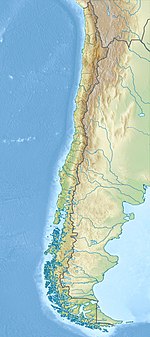| Abanico Formation | |
|---|---|
| Stratigraphic range: Eocene–Miocene (typically Tinguirirican) | |
| Type | Geological formation |
| Underlies | Farellones Formation |
| Overlies | Colimapu Formation |
| Thickness | ca. 3,000 m (9,800 ft) |
| Lithology | |
| Primary | Volcaniclastic sediments comprising basalts, andesites & minor dacites |
| Other | Zeolite |
| Location | |
| Coordinates | 35°00′S 70°24′W / 35.0°S 70.4°W |
| Approximate paleocoordinates | 36°54′S 62°36′W / 36.9°S 62.6°W |
| Region | O'Higgins, Santiago Metropolitan & Valparaíso Regions (Chile) Mendoza Province (Argentina) |
| Country | Chile, Argentina |
| Extent | Abanico Basin |
| Type section | |
| Named for | Cerro El Abanico |
Abanico Formation (Spanish: Formación Abanico) is a 3 kilometres (9,800 ft) thick sedimentary formation exposed in the Andes of Central Chile.[1] The formation has been deposited in a timespan from the Eocene to the Miocene. Abanico Formation's contact with the overlying Miocene Farellones Formation has been the subject of differing interpretations since the 1960s.[2] A small part of the formation crops out in the Mendoza Province of western Argentina.[3]
